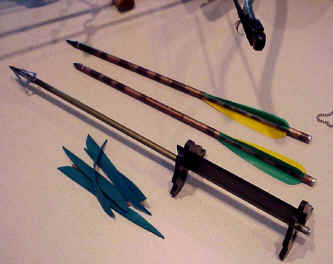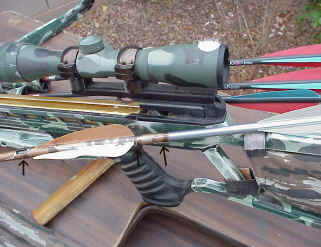|
|
Bow versus Crossbow Bow hunters say the crossbow is evil and gives an unfair advantage, but what is the real lowdown on the two?
I had only just stepped onto the archery club range when a very polite range master
explained to me that they did not allow my type at their range. I
assumed that it was a membership issue and asked about the price to
join. He explained that I would not be able to join. I thought
for a moment that maybe it was a racial thing, but when I looked at the line
of shooters I saw a classic southwestern mix. So what was it? The range master continued politely, trying his best to explain a difficult point I had yet to understand. "It's not you sir, it's your crossbow. We don't allow crossbows on this range." Although I was stunned, I maintained composure and listened to his well rehearsed reasons. Being new to archery at that time I accepted what he told me until I could research it on my own. It was not long before I was hearing the same anti-crossbow propaganda from a number of other archers, although most were far less polite about it. Many actually bordered on real hostility. I was surprised. Was I still living in the dark ages where crossbows were considered evil? I was not, but I had just met a handful of people that probably still held a grudge against Galileo. Now, all this is not to meant as a slam against archery enthusiasts. These were simply people who lacked any first hand knowledge and were repeating the misinformation they had been told at one time or another. As a whole, I have found bow hunters to be a conscienscous group and the best representatives of hunters as a whole. Bow hunting is damn hard and takes a commendable amount of discipline to do. The following is a list of complaints/misinformation commonly propagated on the subject: 1) Crossbows are too powerful and therefore an unfair advantage when hunting. 2) The crossbow is so powerful that the bolts destroy bales of hay used as backstops. 4) The use of telescopic sights violates the purity of archery as a means of hunting. Let's cover some of these modern myths about the two by first
interjecting my own underlying belief: Unless you are shooting a
primitive bow (i.e.: longbows, recurves, no pulleys, etc) you have no place to
make any of the allegations listed above. The guys like
Let's go through these myths point by point: 1) Crossbows are too powerful and therefore an unfair advantage when hunting. This statement is only partially true. Most crossbows on the market are of at least 150lb draw strength. Most bows on the market can be set as high as 60-75lb draw. However, the power stroke (distance the string travels from rest to full draw) on a crossbow is usually little better than 14". On a bow, the power stroke can be as much as 31". It is during the power stroke that an arrow gains its velocity. It is pretty easy to see how these two factors balance each other out. What it really comes down to is how heavy is your arrow (bolt) and how fast is it traveling? Currently, the fastest crossbows on the market throw a factory arrow at 340fps. This speed can be matched by a number of bows on the market currently. The only advantage there would be the difference in price (favoring the crossbow.) A bow fires a heavier arrow with better terminal ballistics out past 50 yards. Two other serious considerations to be taken into account is that the crossbow makes more noise when fired and follow up shots are slower. But, the crossbow can be bench-rested on any handy tree or blind while the shooter takes as long as he needs to make the shot.
2) The crossbow is so powerful that the bolts destroy bales of hay used as backstops. This statement is also founded in a certain measure of truth. Actually bolts do no more damage to bales of hay and straw than do arrows. They don't even penetrate any deeper, but what happens is that the shorter bolt (14-20") will literally disappear into a bale whereas a 30" arrow would still have its shaft protruding for the archer to retrieve their projectiles. So what happens? Crossbow shooters (who lack respect for the archery club's range) tear into the bale trying to recover their bolts (that they were told not to use on bales of hay in the first place.) Then the next day when the range master comes in he finds a demolished bale on his range and rightly curses crossbow users. Bottom line: If you find an archery club that will let you shoot on their range, bring your own target. Ethafoam targets for crossbows are considerably thicker in order to stop the bolt before it over penetrates and shears off the fletchings. Ripped up bales are not a crossbow issue, but rather an issue of rude visitors. It's understandable why range masters would despise crossbows.
Were it that crossbows had a monopoly on triggers I would be forced to agree with that statement. But the real truth is that triggers are available (and widely used) for bows. In fact, the bow hunter gets a way better deal out of it all.
But with a bow, there are dozens of triggers available and most cost almost nothing compared to a crossbow trigger job. Better yet, many are adjustable. Even if you don't like the trigger you bought first, you can toss it in a drawer and go buy another brand. I sure wish I could just drop in a Timney trigger like that. 4) The use of telescopic sights violates the purity of archery as a means of hunting. I agree. Personally I have long felt that the true purists, those who hunt with primitive bows should have a special bow season above and beyond that enjoyed by compound bows and crossbows. Now that I have ticked off a whole class of people, let me lay this on you. Modern bow sights are actually better than the telescopic sights on crossbows (actually bows can now be outfitted with any sight you want including laser sights.) How could this be so? The modern box site for a bow usually has a series of pins that are individually adjustable for both elevation and windage. With a scope though, there are usually a series of crosshairs with windage marks. The real burn is that you cannot individually adjust the various crosshairs. Usually this works, but often you find that your 35 or 45 yard reticules shoot a little high or low. Given the choice I would prefer a box site and forgo the magnification.
This is another one of those user-related issues. The real culprit here (if this is actually a regularly occurring issue) is the hunter. Your point of aim should be the same regardless of whether you hunt with a bow, a rifle, or even a pistol. To me, people who hunt without developing the necessary skills to be proficient are no different than slobs who shoot from the back of their truck. There was a very brief period of time that I actually began to believe this (for lack of my own research.) So there I was acting all proud on the range thinking that my crossbow was significantly more powerful than any bow on the range (I'd seen the movie The Flying Geese a few times) when the guy next to me began shooting a 25 yard group no bigger than a quarter. I asked him if he had any trouble with splitting his own arrows with a group like that. "No, I shoot the clock." he replied. "Shoot the what?" A term I had not yet heard of. "Shoot the clock, my first arrow is at twelve o'clock, the second arrow at three o'clock, and so on." He pointed out matter of factly. "That's not a clock, that's a wrist watch buddy." I commented. So I switched to the 35 yard target and continued shooting. Before long, he was shooting a smaller 45 yard group than my 25 yard group. Finally, he switched to the 80 yard target and his group opened up a little (very little at that!) As I stood marveling at what was the archery equivalent of a one-hole group, he turned to me and said "And that's my slow bow." As it turned out I was shooting beside a sponsored shooter who made his living with a bow. He found my Barnett RC-150 crossbow interesting and even commented that they had carried an almost identical crossbow at Air America back in the 60's. It was at that point that he explained to me in a most grandfatherly way that even the best crossbow on the market would shoot accurately out to about 80 yards (in the hands of a pro) but that for hunting purposes my maximum effective range was more like 45 yards. What surprised me was that he admitted that despite his skill with the bow, he himself would rarely take a shot beyond the 45 yard mark because too much energy was bled off the arrow past that point.
For those of you who watched The Wild Geese and came away believing that a 200 yard head-shot (in the dark, no less) was within the capabilities of your average, off-the-shelf crossbow. However, a more accurate depiction of the crossbow in a wartime application can be seen in the movie Green Berets. There you will see sentries being dispatched at 10 to 15 yards. The only archery devices that get 200 yards are pneumatically powered. Don't believe that Hollywood BS. I would love to tell you that the crossbow really is a magical device, but the fact is that most crossbows use the same limbs as bows offered by the same manufacturer. Granted, there have been crossbows throughout history that were of staggering power and range (most notable was a crew serviced, magazine fed behemoth that fired 1 lb quills up to a mile), but modern commercial grade crossbows are really little different from their bow cousins. As a hunter you should be more concerned with game laws in your state and how they apply to these devices. Most states either do not allow crossbows for hunting or severely limit their use/season. In Arizona crossbows are only allowed during general rifle season, HAM hunts (handgun/archery/muzzleloader), and black powder season. Note that I did not mention archery season because they are prohibited for those hunts unless a physical disability exists. APC
|
|||






 Kids
really have it made these days. When I was a kid if you wanted a bow
you had to go find just the right tree and start whittlin'... Nowadays parents
have a wide choice of beginner bows including several compound bows.
This Barnett Lil' Sioux retails for about $24.99.
Miniature compound bows are also available as well.
Kids
really have it made these days. When I was a kid if you wanted a bow
you had to go find just the right tree and start whittlin'... Nowadays parents
have a wide choice of beginner bows including several compound bows.
This Barnett Lil' Sioux retails for about $24.99.
Miniature compound bows are also available as well. 


